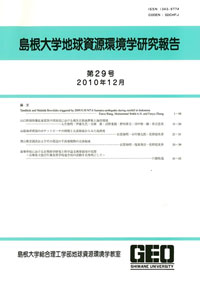島根大学総合理工学部地球資源環境学教室
ISSN:1343-9774

ダウンロード数 : ? 件
この文献の参照には次のURLをご利用ください : https://ir.lib.shimane-u.ac.jp/6125
島根大学地球資源環境学研究報告 22
2003-12-27 発行
島根県、鮮新-更新統都野津層の三角州堆積物
Delta deposits discovered in the Plio-Pleistocene Tsunozu Formation,Shimane Prefecture,southwest Japan
ファイル
内容記述(抄録等)
The Plio-Pleistocene Tsunozu Formation is widely distributed in central and western Shimane Prefecture,southwest Japan.The Tsunozu Formation is composed of up to 100 m of unconsolidated mud,sand,and gravel beds,in which marine or nonmarine deposits repeatedly appear.Because the distribution of this foeration is divided by a topographic high of basement rock,correlation of strata between the separated areas has been discussed in previous studies.Intervals referred to as“Marine Clay”have previously been used for correlation of strata because of poor age control and lack of tephrostratigraphy.
Facies analysis of the Tsunozu Formation along a traceable tuff bed in the Gotsu area identifies 5 depositional facies:(1)bay(marine clay),(2)interdistributary bay or flood plain,(3,4)two types of fluvial channel and(5)delta front deposits.Some of the fluvial channel beds show convex-up lobate geometry,changing laterally into the interdistributary bay facies.Features of the facies and their lateral changes indicate that the sediments were deposited in a small-scale birdfoot delta system developed in a bay head environment.Facies distribution in the reconstructed shore-parallel and shore-normal sections shows poor lateral facies continuity of the bay head facies in the interval studied.This implies that bay mud beds“Marine Clay”should not be used as key beds,even within single segments of the distribution of this formation.
Facies analysis of the Tsunozu Formation along a traceable tuff bed in the Gotsu area identifies 5 depositional facies:(1)bay(marine clay),(2)interdistributary bay or flood plain,(3,4)two types of fluvial channel and(5)delta front deposits.Some of the fluvial channel beds show convex-up lobate geometry,changing laterally into the interdistributary bay facies.Features of the facies and their lateral changes indicate that the sediments were deposited in a small-scale birdfoot delta system developed in a bay head environment.Facies distribution in the reconstructed shore-parallel and shore-normal sections shows poor lateral facies continuity of the bay head facies in the interval studied.This implies that bay mud beds“Marine Clay”should not be used as key beds,even within single segments of the distribution of this formation.
Other Article
PP. 93 - 105
PP. 107 - 110
PP. 111 - 120
PP. 121 - 133
PP. 161 - 166
PP. 167 - 172
